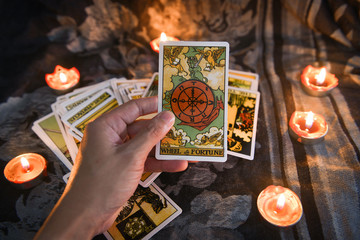Tarot is an ancient form of cartomancy that provides insights and guidance. It can also help us slow down our desire for quick fixes. In fact, it can even remind us to have faith in the process.
Many books and classes are available to learn how to read tarot cards.
The first step in doing a tarot reading is to prepare the cards. This means making sure the deck is clean and shuffled well. Then, you can create a comfortable space and set an intention for the reading. This is important to help you stay focused and avoid getting lost in the cards. You can use a candle, incense or soothing music to create the right atmosphere. It’s also a good idea to write down any questions you may have before the reading so you can ask them.
The next step is to take a moment to check your own energy before beginning the reading. It’s common to feel overwhelmed or exhausted after a session with the tarot, and it’s important to make sure your energy is clear before proceeding. To do this, try deeply inhaling and exhaling to calm yourself or cleanse your aura with a lavender smudge stick.
Once you’ve cleared your energy, it’s time to shuffle the cards and begin your reading. When shuffling the cards, you should use whatever method feels natural to you. Some readers cut the deck into two files and fan them, while others prefer to mix the cards in a large pile on the floor. Whatever you choose, remember to focus on the weight of the cards and the way they feel in your hand.
There are many different ways to read tarot, but a good starting point is the three-card spread. This consists of the Past, Present, and Future cards positioned left to right in front of you. Another popular spread is the Situation-Action-Outcome, which is perfect for situations that need clarity or direction.
You can also experiment with different tarot card layouts to find which one works best for you. Each layout offers unique insights into a question or situation. Some are easier to interpret than others, but with practice you’ll be able to develop your own interpretations of the cards and their meanings.
Reading tarot for others can be a bit nerve-wracking, but it’s a great way to become familiar with the cards and improve your intuitive gifts. It’s also a great way to work on your accuracy and confidence. With a little preparation, you can give your clients a meaningful and insightful reading.
Tarot spreads
A tarot reading is a powerful tool for personal growth and exploration. It can help you gain clarity about any situation, as long as you understand the meanings behind each card and how they interact with one another. You can use a single card for a simple reading, or several cards for a spread that speaks more broadly to your current situation. Beginners may want to start with a small spread and then work their way up to more complex ones.
Advanced tarot spreads offer more complex interpretations and deeper insights. For example, the Astrological Spread uses a circular formation of twelve cards to provide guidance on personal growth and goal-setting based on zodiac signs. These spreads can be difficult for beginners to interpret, but they are a great stepping stone for those looking to incorporate tarot into their spiritual practice.
The Celtic Cross Tarot spread is a popular choice for relationship questions. It can be used to answer questions about the past, present, and future of a relationship. The first card of the three-card row shows the current state of a relationship, while the second card reveals a core obstacle that needs to be overcome. The final card offers a glimpse into the potential future of the relationship.
Another popular tarot spread is the Success Spread, which is a remarkably situational spread. It can be used to determine if a project or business venture is likely to succeed, or if there are any threats that need to be dealt with. This is an ideal spread for evaluating personal and business success in the face of challenges.
When using this spread, it is important to pay close attention to the positioning of each card. The relationship between the cards is also important, as opposite suits ill-dignify each other, and the number pattern of a suit can reveal special messages. For instance, a few majors may indicate higher forces at play, and a lot of cups suggest strong emotions. It is also important to notice any patterns that may occur among the cards, such as having several suits of the same element or a significant number of majors.
Tarot cards
The tarot is an ancient tool for divination, used by people across a wide range of cultures and beliefs. It can help provide insight on a variety of questions, from health and financial issues to what is most important for spiritual growth. Using tarot cards can be a cathartic and healing experience. However, it is important to remember that tarot readings are a form of divination, and not to be taken as literal predictions.
It is not difficult to learn to read tarot, though it requires patience and commitment. Most new readers start by buying a deck and finding a guidebook that can teach them the basics. A good book will explain the symbolism of each card, and offer tips on spreads and reading etiquette. It will also explain how to set up your space to best receive intuitive messages from the cards.
Tarot is a popular practice at this time because it can help people find meaning in their lives. It can also give them guidance on personal issues, such as relationships and career decisions. It can also be helpful for those who are dealing with depression, addiction, or other mental health issues. Incorporating tarot into a daily or weekly routine can help grow one’s intuitive abilities and tap into their inner wisdom.
The tarot contains 78 cards, divided into two sections: the Major Arcana and the Minor Arcana. The Major Arcana are 22 cards, or trumps, that don’t have numbered suits and include The Fool, The Magician, The High Priestess, The Tower, and The World. The Minor Arcana are the other 56 cards, which are arranged into four suit categories: swords or batons, coins or pentacles, cups, and the wands or staffs. There are ten numbered cards in each suit, along with the King, Queen, Prince or Princess, and Knight cards.
When a querent draws a card from a deck, it is called a “reading.” The cards represent aspects of the querent’s past, present, and future, and each card has its own unique meaning. The interpretation of a reading is subjective and will differ for every reader. It is important to note that a tarot reading is not a replacement for professional advice, and it should be treated with empathy and compassion.
Getting a tarot reading
When it comes to getting a tarot reading, you should have clear questions in mind before you sit down with the cards. You can ask a question about love, career, family, or anything else that you want clarity on. The cards will provide you with guidance based on your own energy and intuition. You can also use the tarot to gain insight into past experiences and future possibilities.
Getting a tarot reading is a form of cartomancy, or divination, that taps into your energy and the wisdom of the universe to offer insight into all aspects of life. It is a great tool for self-discovery and can give you a new perspective on any situation. If you are a beginner, it is recommended to see a professional tarot reader to get an outside perspective and learn the cards’ meanings.
The first step is to select a deck that resonates with you. You can choose a classic deck, one inspired by pop culture, or something completely different. Once you have chosen your deck, it is time to shuffle and cut the cards. You can do this in any way that feels comfortable to you – for example, you could hold the deck in one hand and release a section of cards into the opposite hand; you could also fan the cards or place them in a pile on the floor. The most important thing is to focus on the central question of your reading and not lose track of the cards as you shuffle.
It is also a good idea to keep a journal of your readings, so you can remember the symbols and imagery that the cards represent. Keeping a record of your readings will help you to build your own personal interpretations and will also allow you to see any patterns that emerge over time. You can even make a photo album of your tarot readings and share them with others.
When you are ready to read tarot for others, it is a good idea to practice on friends or relatives first. It is essential to be honest with your clients and always treat them with respect. If they have serious issues, it is best to refer them to a mental health professional instead of offering tarot advice.



